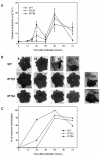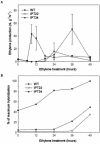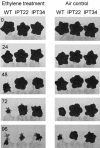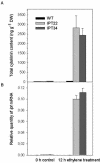Overproduction of cytokinins in petunia flowers transformed with P(SAG12)-IPT delays corolla senescence and decreases sensitivity to ethylene
- PMID: 12913172
- PMCID: PMC181301
- DOI: 10.1104/pp.103.023945
Overproduction of cytokinins in petunia flowers transformed with P(SAG12)-IPT delays corolla senescence and decreases sensitivity to ethylene
Abstract
Plant senescence is regulated by a coordinated genetic program mediated in part by changes in ethylene, abscisic acid (ABA), and cytokinin content. Transgenic plants with delayed senescence are useful for studying interactions between these signaling mechanisms. Expression of ipt, a cytokinin biosynthetic gene from Agrobacterium tumefaciens, under the control of the promoter from a senescence-associated gene (SAG12) has been one approach used to delay senescence. We transformed petunia (Petunia x hybrida cv V26) with P(SAG12)-IPT. Two independently transformed lines with extended flower longevity (I-1-7-22 and I-3-18-34) were used to study the effects of elevated cytokinin content on ethylene synthesis and sensitivity and ABA accumulation in petunia corollas. Floral senescence in these lines was delayed 6 to 10 d relative to wild-type (WT) flowers. Ipt transcripts increased in abundance after pollination and were accompanied by increased cytokinin accumulation. Endogenous ethylene production was induced by pollination in both WT and IPT corollas, but this increase was delayed in IPT flowers. Flowers from IPT plants were less sensitive to exogenous ethylene and required longer treatment times to induce endogenous ethylene production, corolla senescence, and up-regulation of the senescence-related Cys protease phcp1. Accumulation of ABA, another hormone regulating flower senescence, was significantly greater in WT corollas, confirming that floral senescence was delayed in IPT plants. These results extend our understanding of the hormone interactions that regulate flower senescence and provide a means of increasing flower longevity.
Figures






Similar articles
-
Ethylene-sensitivity regulates proteolytic activity and cysteine protease gene expression in petunia corollas.J Exp Bot. 2005 Oct;56(420):2733-44. doi: 10.1093/jxb/eri266. Epub 2005 Aug 30. J Exp Bot. 2005. PMID: 16131506
-
Flower-specific expression of the Agrobacterium tumefaciens isopentenyltransferase gene results in radial expansion of floral organs in Petunia hybrida.Plant Biotechnol J. 2008 Sep;6(7):694-701. doi: 10.1111/j.1467-7652.2008.00349.x. Epub 2008 May 8. Plant Biotechnol J. 2008. PMID: 18482222
-
A Petunia homeodomain-leucine zipper protein, PhHD-Zip, plays an important role in flower senescence.PLoS One. 2014 Feb 14;9(2):e88320. doi: 10.1371/journal.pone.0088320. eCollection 2014. PLoS One. 2014. PMID: 24551088 Free PMC article.
-
Regulation of volatile benzenoid biosynthesis in petunia flowers.Trends Plant Sci. 2006 Jan;11(1):20-5. doi: 10.1016/j.tplants.2005.09.009. Epub 2005 Oct 12. Trends Plant Sci. 2006. PMID: 16226052 Review.
-
The Mode of Cytokinin Functions Assisting Plant Adaptations to Osmotic Stresses.Plants (Basel). 2019 Nov 26;8(12):542. doi: 10.3390/plants8120542. Plants (Basel). 2019. PMID: 31779090 Free PMC article. Review.
Cited by
-
Integrated signaling in flower senescence: an overview.Plant Signal Behav. 2007 Nov;2(6):437-45. doi: 10.4161/psb.2.6.4991. Plant Signal Behav. 2007. PMID: 19517004 Free PMC article.
-
Senescence is delayed when ramie (Boehmeria nivea L.) is transformed with the isopentyl transferase (ipt) gene under control of the SAG12 promoter.FEBS Open Bio. 2017 Mar 31;7(5):636-644. doi: 10.1002/2211-5463.12191. eCollection 2017 May. FEBS Open Bio. 2017. PMID: 28469976 Free PMC article.
-
From Survival to Productivity Mode: Cytokinins Allow Avoiding the Avoidance Strategy Under Stress Conditions.Front Plant Sci. 2020 Jul 2;11:879. doi: 10.3389/fpls.2020.00879. eCollection 2020. Front Plant Sci. 2020. PMID: 32714345 Free PMC article.
-
Regulated expression of a cytokinin biosynthesis gene IPT delays leaf senescence and improves yield under rainfed and irrigated conditions in canola (Brassica napus L.).PLoS One. 2015 Jan 20;10(1):e0116349. doi: 10.1371/journal.pone.0116349. eCollection 2015. PLoS One. 2015. PMID: 25602960 Free PMC article.
-
Proteomic analysis of pollination-induced corolla senescence in petunia.J Exp Bot. 2010 Feb;61(4):1089-109. doi: 10.1093/jxb/erp373. Epub 2010 Jan 28. J Exp Bot. 2010. PMID: 20110265 Free PMC article.
References
-
- Baker JE (1983) Preservation of cut flowers. In LG Nickell, ed, Plant Growth Regulating Chemicals. CRC Press, Boca Raton, FL, pp 177-191
-
- Banowetz GM (1992) The effects of endogenous cytokinin content on benzyladenine-enhanced nitrate reductase induction. Physiol Plant 86: 341-348
-
- Banowetz GM, Hess JR, Carman JG (1994) A monoclonal antibody against the plant growth regulator, abscisic acid. Hybridoma 13: 537-541 - PubMed
-
- Barden LE, Hanan JJ (1972) Effect of ethylene on carnation keeping life. J Am Soc Hortic Sci 97: 785-788
Publication types
MeSH terms
Substances
LinkOut - more resources
Full Text Sources
Other Literature Sources

